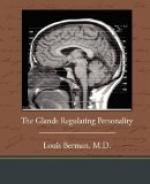THE NEURASTHENIC GENIUS
The fin de siecle intelligentsia of the nineteenth century were quite stirred up by a publication of Max Nordau on “Degeneration,” in which a number of revered artists and intelligents were held up to public scorn as degenerates and neurasthenics. So wrought up were they, in fact, that Bernard Shaw was moved to compose a defense entitled “The Sanity of Art.” In spite of the Great Vegetarian’s dialectics, it remains to be explained why a certain species of creative ability has been combined with the fatigability, variability and general wretched irritability of every organ and tissue in the body which taught them that they were sensitive souls imprisoned in the flesh. Going from doctor to doctor as from pillar to post, from this medical creed to that hygienic cult, lucky to escape the worst, often landing upon the bosom of New Thought for succor. We have noted in previous chapters the relation of neurasthenia to the glands of internal secretion in general, and to adrenal insufficiency in particular. A closer examination of neurasthenic genius will show it to consist essentially of a pituitocentric in whom for one reason or another, congenital (the persistence of the thymus) or acquired (shocks, accidents, diseases) there has been failure of the adrenals, thyroid or the interstitial cells, about in the order of their occurrence.
THE CASE OF NIETZSCHE
Friedrich Nietzsche is about as good a case as there is on record of a genius blasted by migraine. The originality and force of his mind, as well as the articulate music of an imaginative poet, places Nietzsche among the philosophic elect of the race. Showing that he was an unstable pituitary-centered of a certain type will throw light upon his malady, as well as upon his life and work.
In a set of volumes, entitled Biographic Clinics, Dr. George M. Gould of Philadelphia contended that the ill health of a number of men and women of genius of the nineteenth century was due to unconnected eye troubles. In attempting to bolster up his thesis he has collected biographic material useful to the student of personality. He never appears to have asked himself what was behind the eye trouble. The evidence relating to Nietzsche’s endocrine personality is derived from some of the data he collected, as well as from the two volume life of the philosopher written by his sister, and the other biographies of him extant.




